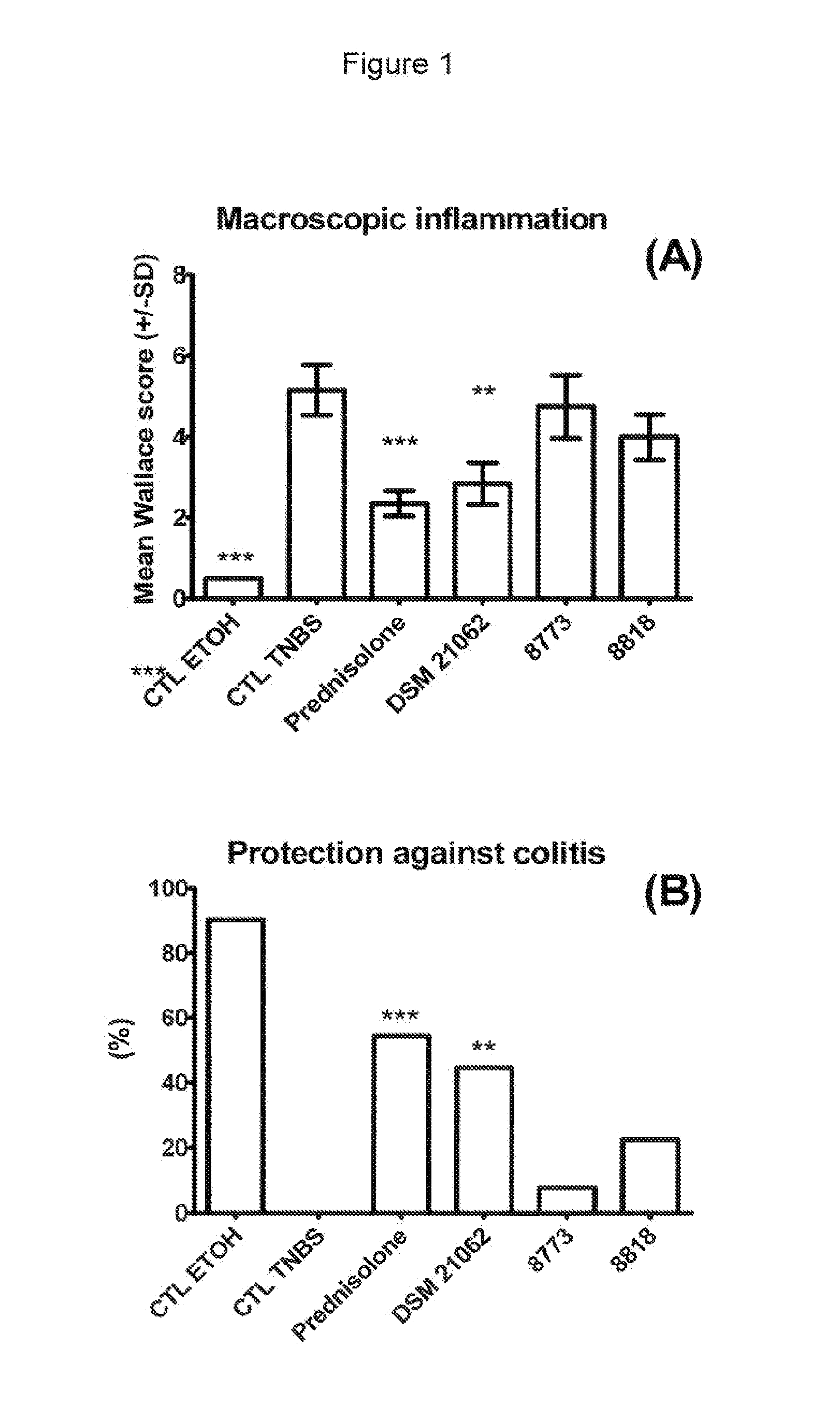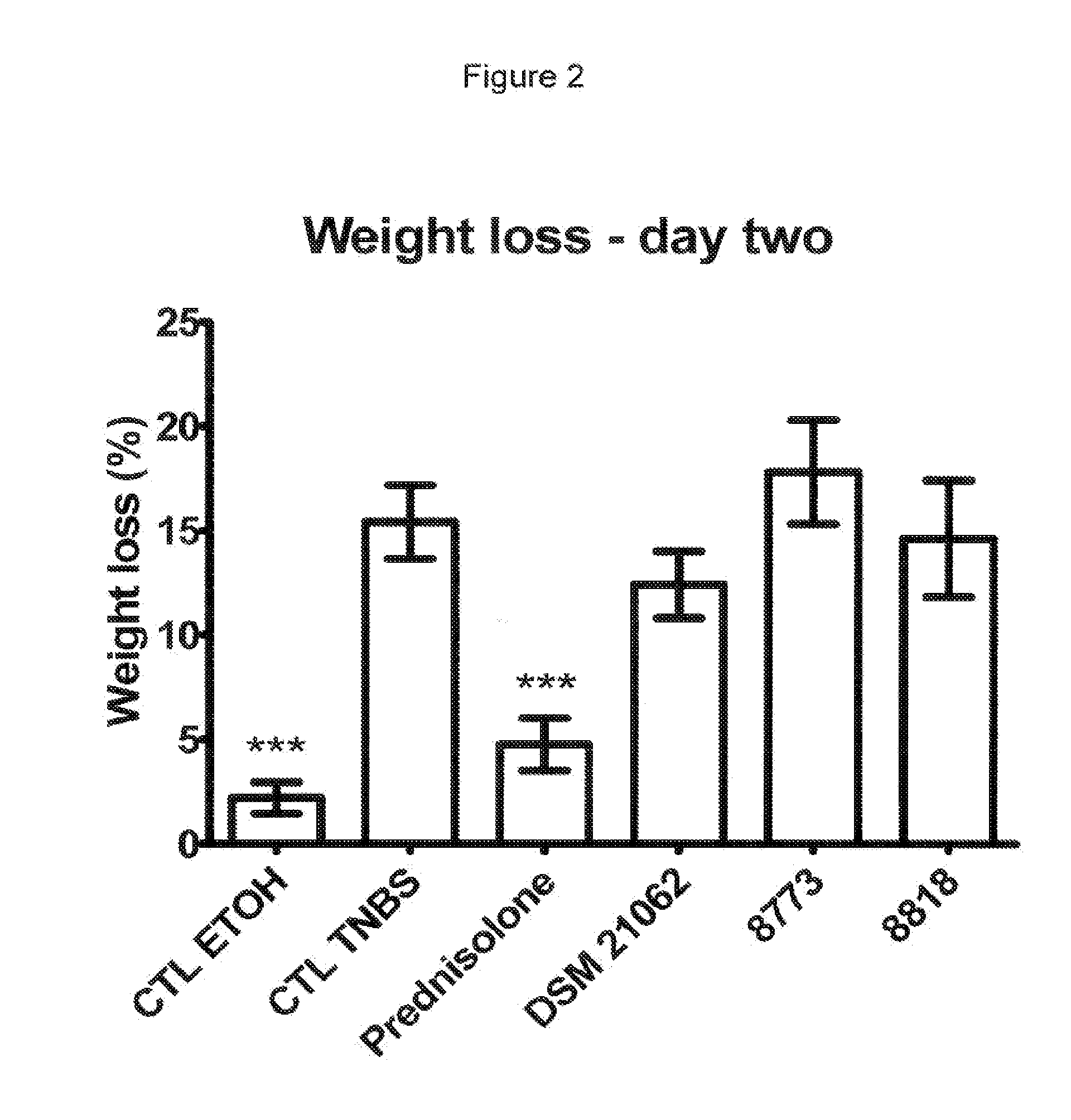Probiotic bifidobacterium longum
a technology of bifidobacterium longum and probiotics, which is applied in the field of new probiotics, probiotics, antiinflammatory strains of bifidobacterium longum, can solve the problems of imposing rather divergent effects on health, inflammation and tissue damage, and the inability to accurately predict the taxonomy of probiotic bacteria, so as to improve the effect of gastrointestinal disease prevention and treatment, and prolonging the life of individuals
- Summary
- Abstract
- Description
- Claims
- Application Information
AI Technical Summary
Benefits of technology
Problems solved by technology
Method used
Image
Examples
example 1
In Vivo Analysis of Anti-Inflammatory Potential of Bifidobacterium longum DSM 21062
Culture Conditions and Strains Used
[0105]In the present study the following strains were used: Bifidobacterium longum strain DSM 21062 (CHCC8879). The strains Lactobacillus ruminis strain CHCC8818, Lactobacillus paracasei strain CHCC8773, Bifidobacterium bifidum strain CHCC9555 and Bifidobacterium bifidum strain CHCC9553 were used a control strains. Strain CHCC8818, CHCC8773, CHCC9555 and CHCC9553 are 4 putative probiotic strains of the Chr. Hansen culture collection identified and studied in the screening procedure resulting in the present invention.
[0106]Lactobacilli were grown in MRS broth (Difco, BD Diagnostics, Sparks, Md., USA) at 37° C. Bifidobacteria were grown at 37° C. in MRS broth+0.05% hydrochloride cysteine, using Anaerocult A incubation bags (Merck, Darmstadt, Germany).
[0107]For each strain, the OD 600 nm / CFU (colony forming units) correspondence has been established on the basis of grow...
example 2
EPS Purification, Quantification and Composition of the Strains
Culture Conditions
[0121]Lactobacilli were grown 24-48 hrs in 200 ml MRS at 37° C. Bifidobacteria were grown at 37° C. in 200 ml MRS+0.05% hydrochloride cysteine, using Anaerocult A incubation bags (Merck) for 24-48 hrs.
EPS Purification
[0122]EPS purification was carried out essentially as described in (36). Briefly, after growth of 200 ml bacterial cultures, trichloroacetic acid was added to the cultures to a final concentration of 4%. Cells and protein were removed by centrifugation and the supernatant passed through a 0.2 μm filter. The EPS were precipitated by addition of an equal volume of ice cold ethanol. The precipitate was collected by centrifugation and the EPS re-dissolved in purified water.
Monosaccharide Composition and Concentration
[0123]The analysis of the monosaccharide composition of the purified EPS was performed by high pH anion exchange chromatography (HPAEC) as described by (3). Briefly, purified EPS so...
example 3
Strain Bulkiness and Thickness
Strain Bulkiness
[0126]The strains were cultivated as described above. The optical density of the individual strains was adjusted to 4.04 (OD at 600 nm), i.e. adjusted to same amount of bacterial biomass. Ten ml of the strains DSM 21062, CHCC8773 and CHCC8818 were subsequently centrifuged at 2400×g for 15 min in 15 ml conical tubes.
Results
[0127]The height of the pellets was 16, 5 and 4 mm for the strains DSM 21062, CHCC8773 and CHCC8818, respectively (see FIG. 4). The bulkiness of DSM 21062 confirms that this strain produces high amounts of exopolysaccharide and possibly also capsular polysaccharide.
Strain Thickness
[0128]The strains were cultivated as described above. The optical density of the individual strains was adjusted to 4.04 (OD at 600 nm). The rheological measurements were performed on a Stresstech Rheometer (Rheologica AB, Lund, Sweden) using a standard C25 bob and cup geometry (2.5 cm in diameter). The samples were tempered to 13° C. in a the...
PUM
| Property | Measurement | Unit |
|---|---|---|
| Mass | aaaaa | aaaaa |
| Fraction | aaaaa | aaaaa |
| Fraction | aaaaa | aaaaa |
Abstract
Description
Claims
Application Information
 Login to View More
Login to View More - R&D
- Intellectual Property
- Life Sciences
- Materials
- Tech Scout
- Unparalleled Data Quality
- Higher Quality Content
- 60% Fewer Hallucinations
Browse by: Latest US Patents, China's latest patents, Technical Efficacy Thesaurus, Application Domain, Technology Topic, Popular Technical Reports.
© 2025 PatSnap. All rights reserved.Legal|Privacy policy|Modern Slavery Act Transparency Statement|Sitemap|About US| Contact US: help@patsnap.com



